Xinyi Zhang
University of British Columbia
MegaScale-Infer: Serving Mixture-of-Experts at Scale with Disaggregated Expert Parallelism
Apr 03, 2025Abstract:Mixture-of-Experts (MoE) showcases tremendous potential to scale large language models (LLMs) with enhanced performance and reduced computational complexity. However, its sparsely activated architecture shifts feed-forward networks (FFNs) from being compute-intensive to memory-intensive during inference, leading to substantially lower GPU utilization and increased operational costs. We present MegaScale-Infer, an efficient and cost-effective system for serving large-scale MoE models. MegaScale-Infer disaggregates attention and FFN modules within each model layer, enabling independent scaling, tailored parallelism strategies, and heterogeneous deployment for both modules. To fully exploit disaggregation in the presence of MoE's sparsity, MegaScale-Infer introduces ping-pong pipeline parallelism, which partitions a request batch into micro-batches and shuttles them between attention and FFNs for inference. Combined with distinct model parallelism for each module, MegaScale-Infer effectively hides communication overhead and maximizes GPU utilization. To adapt to disaggregated attention and FFN modules and minimize data transmission overhead (e.g., token dispatch), MegaScale-Infer provides a high-performance M2N communication library that eliminates unnecessary GPU-to-CPU data copies, group initialization overhead, and GPU synchronization. Experimental results indicate that MegaScale-Infer achieves up to 1.90x higher per-GPU throughput than state-of-the-art solutions.
Integrating Language-Image Prior into EEG Decoding for Cross-Task Zero-Calibration RSVP-BCI
Jan 06, 2025



Abstract:Rapid Serial Visual Presentation (RSVP)-based Brain-Computer Interface (BCI) is an effective technology used for information detection by detecting Event-Related Potentials (ERPs). The current RSVP decoding methods can perform well in decoding EEG signals within a single RSVP task, but their decoding performance significantly decreases when directly applied to different RSVP tasks without calibration data from the new tasks. This limits the rapid and efficient deployment of RSVP-BCI systems for detecting different categories of targets in various scenarios. To overcome this limitation, this study aims to enhance the cross-task zero-calibration RSVP decoding performance. First, we design three distinct RSVP tasks for target image retrieval and build an open-source dataset containing EEG signals and corresponding stimulus images. Then we propose an EEG with Language-Image Prior fusion Transformer (ELIPformer) for cross-task zero-calibration RSVP decoding. Specifically, we propose a prompt encoder based on the language-image pre-trained model to extract language-image features from task-specific prompts and stimulus images as prior knowledge for enhancing EEG decoding. A cross bidirectional attention mechanism is also adopted to facilitate the effective feature fusion and alignment between the EEG and language-image features. Extensive experiments demonstrate that the proposed model achieves superior performance in cross-task zero-calibration RSVP decoding, which promotes the RSVP-BCI system from research to practical application.
The Value of AI-Generated Metadata for UGC Platforms: Evidence from a Large-scale Field Experiment
Dec 24, 2024Abstract:AI-generated content (AIGC), such as advertisement copy, product descriptions, and social media posts, is becoming ubiquitous in business practices. However, the value of AI-generated metadata, such as titles, remains unclear on user-generated content (UGC) platforms. To address this gap, we conducted a large-scale field experiment on a leading short-video platform in Asia to provide about 1 million users access to AI-generated titles for their uploaded videos. Our findings show that the provision of AI-generated titles significantly boosted content consumption, increasing valid watches by 1.6% and watch duration by 0.9%. When producers adopted these titles, these increases jumped to 7.1% and 4.1%, respectively. This viewership-boost effect was largely attributed to the use of this generative AI (GAI) tool increasing the likelihood of videos having a title by 41.4%. The effect was more pronounced for groups more affected by metadata sparsity. Mechanism analysis revealed that AI-generated metadata improved user-video matching accuracy in the platform's recommender system. Interestingly, for a video for which the producer would have posted a title anyway, adopting the AI-generated title decreased its viewership on average, implying that AI-generated titles may be of lower quality than human-generated ones. However, when producers chose to co-create with GAI and significantly revised the AI-generated titles, the videos outperformed their counterparts with either fully AI-generated or human-generated titles, showcasing the benefits of human-AI co-creation. This study highlights the value of AI-generated metadata and human-AI metadata co-creation in enhancing user-content matching and content consumption for UGC platforms.
Joint Knowledge Editing for Information Enrichment and Probability Promotion
Dec 22, 2024Abstract:Knowledge stored in large language models requires timely updates to reflect the dynamic nature of real-world information. To update the knowledge, most knowledge editing methods focus on the low layers, since recent probes into the knowledge recall process reveal that the answer information is enriched in low layers. However, these probes only and could only reveal critical recall stages for the original answers, while the goal of editing is to rectify model's prediction for the target answers. This inconsistency indicates that both the probe approaches and the associated editing methods are deficient. To mitigate the inconsistency and identify critical editing regions, we propose a contrast-based probe approach, and locate two crucial stages where the model behavior diverges between the original and target answers: Information Enrichment in low layers and Probability Promotion in high layers. Building upon the insights, we develop the Joint knowledge Editing for information Enrichment and probability Promotion (JEEP) method, which jointly edits both the low and high layers to modify the two critical recall stages. Considering the mutual interference and growing forgetting due to dual modifications, JEEP is designed to ensure that updates to distinct regions share the same objectives and are complementary. We rigorously evaluate JEEP by editing up to thousands of facts on various models, i.e., GPT-J (6B) and LLaMA (7B), and addressing diverse editing objectives, i.e., adding factual and counterfactual knowledge. In all tested scenarios, JEEP achieves best performances, validating the effectiveness of the revealings of our probe approach and the designs of our editing method. Our code and data are available at https://github.com/Eric8932/JEEP.
DNF: Unconditional 4D Generation with Dictionary-based Neural Fields
Dec 06, 2024Abstract:While remarkable success has been achieved through diffusion-based 3D generative models for shapes, 4D generative modeling remains challenging due to the complexity of object deformations over time. We propose DNF, a new 4D representation for unconditional generative modeling that efficiently models deformable shapes with disentangled shape and motion while capturing high-fidelity details in the deforming objects. To achieve this, we propose a dictionary learning approach to disentangle 4D motion from shape as neural fields. Both shape and motion are represented as learned latent spaces, where each deformable shape is represented by its shape and motion global latent codes, shape-specific coefficient vectors, and shared dictionary information. This captures both shape-specific detail and global shared information in the learned dictionary. Our dictionary-based representation well balances fidelity, contiguity and compression -- combined with a transformer-based diffusion model, our method is able to generate effective, high-fidelity 4D animations.
An Information Criterion for Controlled Disentanglement of Multimodal Data
Oct 31, 2024Abstract:Multimodal representation learning seeks to relate and decompose information inherent in multiple modalities. By disentangling modality-specific information from information that is shared across modalities, we can improve interpretability and robustness and enable downstream tasks such as the generation of counterfactual outcomes. Separating the two types of information is challenging since they are often deeply entangled in many real-world applications. We propose Disentangled Self-Supervised Learning (DisentangledSSL), a novel self-supervised approach for learning disentangled representations. We present a comprehensive analysis of the optimality of each disentangled representation, particularly focusing on the scenario not covered in prior work where the so-called Minimum Necessary Information (MNI) point is not attainable. We demonstrate that DisentangledSSL successfully learns shared and modality-specific features on multiple synthetic and real-world datasets and consistently outperforms baselines on various downstream tasks, including prediction tasks for vision-language data, as well as molecule-phenotype retrieval tasks for biological data.
Quo Vadis RankList-based System in Face Recognition?
Oct 02, 2024
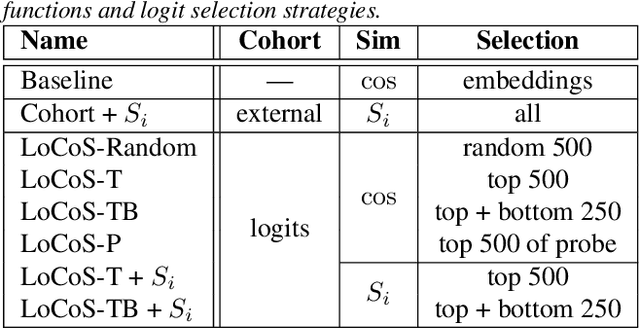

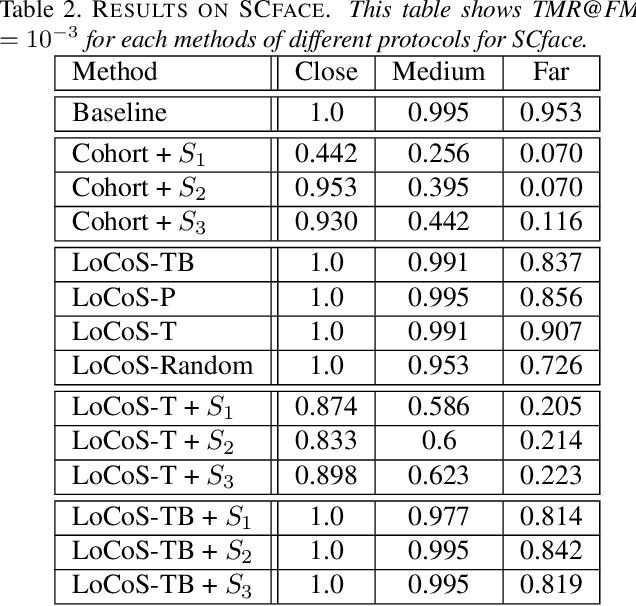
Abstract:Face recognition in the wild has gained a lot of focus in the last few years, and many face recognition models are designed to verify faces in medium-quality images. Especially due to the availability of large training datasets with similar conditions, deep face recognition models perform exceptionally well in such tasks. However, in other tasks where substantially less training data is available, such methods struggle, especially when required to compare high-quality enrollment images with low-quality probes. On the other hand, traditional RankList-based methods have been developed that compare faces indirectly by comparing to cohort faces with similar conditions. In this paper, we revisit these RankList methods and extend them to use the logits of the state-of-the-art DaliFace network, instead of an external cohort. We show that through a reasonable Logit-Cohort Selection (LoCoS) the performance of RankList-based functions can be improved drastically. Experiments on two challenging face recognition datasets not only demonstrate the enhanced performance of our proposed method but also set the stage for future advancements in handling diverse image qualities.
Taming Diffusion Prior for Image Super-Resolution with Domain Shift SDEs
Sep 26, 2024



Abstract:Diffusion-based image super-resolution (SR) models have attracted substantial interest due to their powerful image restoration capabilities. However, prevailing diffusion models often struggle to strike an optimal balance between efficiency and performance. Typically, they either neglect to exploit the potential of existing extensive pretrained models, limiting their generative capacity, or they necessitate a dozens of forward passes starting from random noises, compromising inference efficiency. In this paper, we present DoSSR, a Domain Shift diffusion-based SR model that capitalizes on the generative powers of pretrained diffusion models while significantly enhancing efficiency by initiating the diffusion process with low-resolution (LR) images. At the core of our approach is a domain shift equation that integrates seamlessly with existing diffusion models. This integration not only improves the use of diffusion prior but also boosts inference efficiency. Moreover, we advance our method by transitioning the discrete shift process to a continuous formulation, termed as DoS-SDEs. This advancement leads to the fast and customized solvers that further enhance sampling efficiency. Empirical results demonstrate that our proposed method achieves state-of-the-art performance on synthetic and real-world datasets, while notably requiring only 5 sampling steps. Compared to previous diffusion prior based methods, our approach achieves a remarkable speedup of 5-7 times, demonstrating its superior efficiency. Code: https://github.com/QinpengCui/DoSSR.
Pose Magic: Efficient and Temporally Consistent Human Pose Estimation with a Hybrid Mamba-GCN Network
Aug 07, 2024
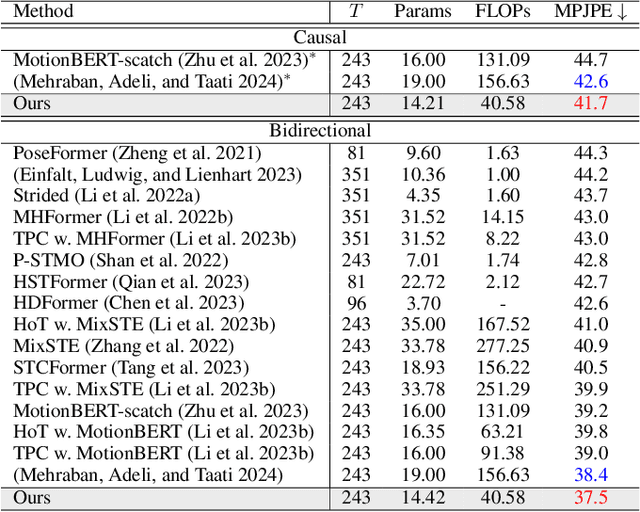


Abstract:Current state-of-the-art (SOTA) methods in 3D Human Pose Estimation (HPE) are primarily based on Transformers. However, existing Transformer-based 3D HPE backbones often encounter a trade-off between accuracy and computational efficiency. To resolve the above dilemma, in this work, we leverage recent advances in state space models and utilize Mamba for high-quality and efficient long-range modeling. Nonetheless, Mamba still faces challenges in precisely exploiting local dependencies between joints. To address these issues, we propose a new attention-free hybrid spatiotemporal architecture named Hybrid Mamba-GCN (Pose Magic). This architecture introduces local enhancement with GCN by capturing relationships between neighboring joints, thus producing new representations to complement Mamba's outputs. By adaptively fusing representations from Mamba and GCN, Pose Magic demonstrates superior capability in learning the underlying 3D structure. To meet the requirements of real-time inference, we also provide a fully causal version. Extensive experiments show that Pose Magic achieves new SOTA results ($\downarrow 0.9 mm$) while saving $74.1\%$ FLOPs. In addition, Pose Magic exhibits optimal motion consistency and the ability to generalize to unseen sequence lengths.
Is Large Language Model Good at Database Knob Tuning? A Comprehensive Experimental Evaluation
Aug 05, 2024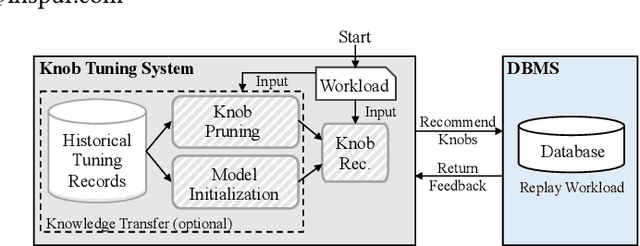

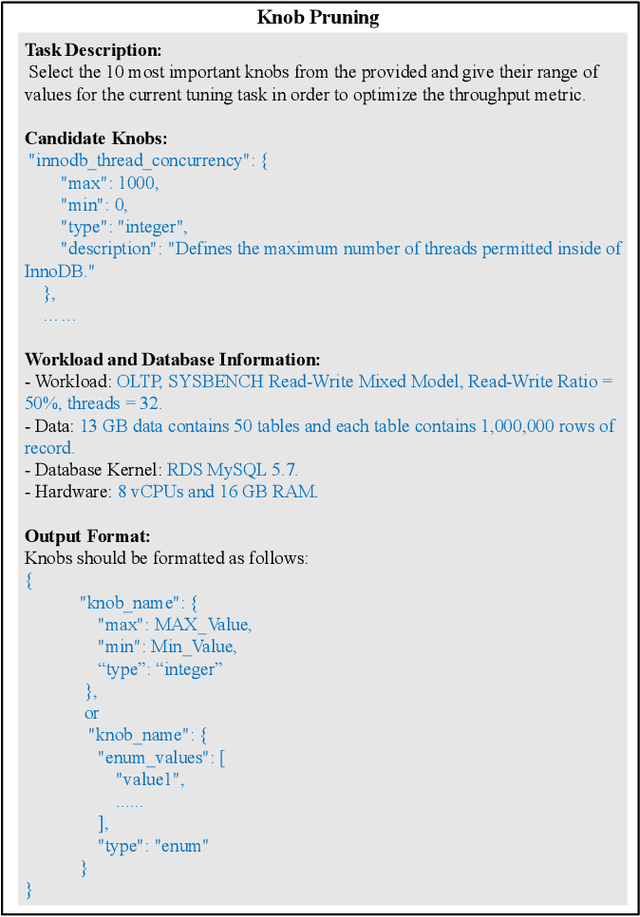
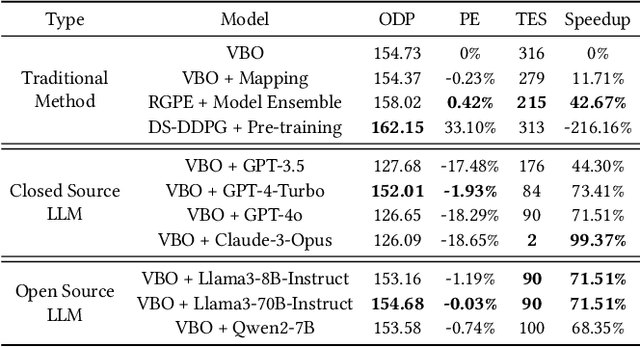
Abstract:Knob tuning plays a crucial role in optimizing databases by adjusting knobs to enhance database performance. However, traditional tuning methods often follow a Try-Collect-Adjust approach, proving inefficient and database-specific. Moreover, these methods are often opaque, making it challenging for DBAs to grasp the underlying decision-making process. The emergence of large language models (LLMs) like GPT-4 and Claude-3 has excelled in complex natural language tasks, yet their potential in database knob tuning remains largely unexplored. This study harnesses LLMs as experienced DBAs for knob-tuning tasks with carefully designed prompts. We identify three key subtasks in the tuning system: knob pruning, model initialization, and knob recommendation, proposing LLM-driven solutions to replace conventional methods for each subtask. We conduct extensive experiments to compare LLM-driven approaches against traditional methods across the subtasks to evaluate LLMs' efficacy in the knob tuning domain. Furthermore, we explore the adaptability of LLM-based solutions in diverse evaluation settings, encompassing new benchmarks, database engines, and hardware environments. Our findings reveal that LLMs not only match or surpass traditional methods but also exhibit notable interpretability by generating responses in a coherent ``chain-of-thought'' manner. We further observe that LLMs exhibit remarkable generalizability through simple adjustments in prompts, eliminating the necessity for additional training or extensive code modifications. Drawing insights from our experimental findings, we identify several opportunities for future research aimed at advancing the utilization of LLMs in the realm of database management.
 Add to Chrome
Add to Chrome Add to Firefox
Add to Firefox Add to Edge
Add to Edge